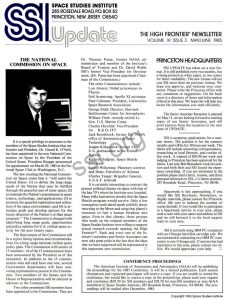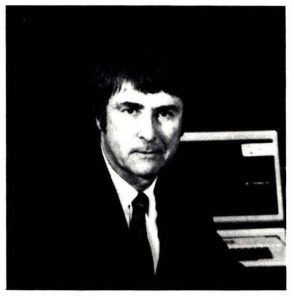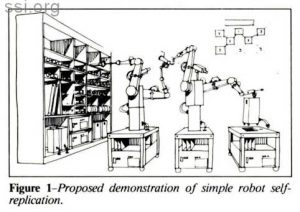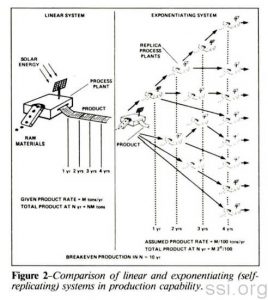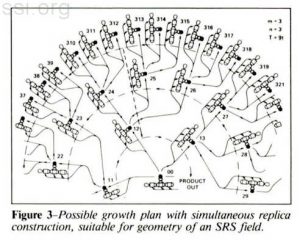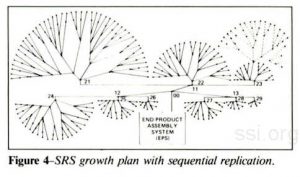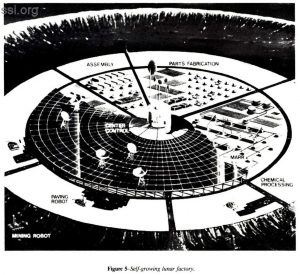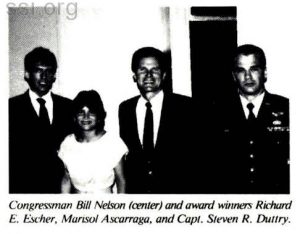SPACE STUDIES INSTITUTE
285 ROSEDALE ROAD, P.O.BOX 82
PRINCETON, NEW JERSEY 08540
[[librarian note: This address is here, as it was in the original printed newsletter, for historical reasons. It is no longer the physical address of SSI. For contributions, please see this page]]
SSI UPDATE
THE HIGH FRONTIER(sm) NEWSLETTER
VOLUME X1 ISSUE 3
MAY/JUNE 1985
THE NATIONAL COMMISSION ON SPACE
It is a special privilege to announce to the members of the Space Studies Institute that our founder and President, Dr. Gerard K. O’Neill, has been appointed to the new National Commission on Space by the President of the United States. President Reagan announced the appointment on March 29, 1985 at the National Space Club in Washington, D.C.
The law creating the National Commission on Space states that it “will assist the United States – (1) to define the long-range needs of the Nation that may be fulfilled through the peaceful uses of outer space; (2) to maintain the Nation’s preeminence in space science, technology, and applications; (3) to promote the peaceful exploration and utilization of the space environment; and (4) to articulate goals and develop options for the future direction of the Nation’s civilian space program.” The Commission is charged with identifying long range goals, opportunities and policy options for U.S. civilian space activity for the next twenty years.
The final output of the Commission will be a report listing options and recommendations for a long range national civilian space policy plan. The Commission will consist of 15 members. 14 of the 15 commissioners have been announced by the President as of this newsletter. In addition to the 15 commissioners who will each have one vote, several Government departments will have nonvoting representatives present in the Commission. Two members of the Senate and the House of Representatives will be selected as advisors to the Commission.
Two other prominent SSI members have been appointed to the Commission. They are Dr. Thomas Paine, former NASA administrator and member of the Institute’s Board of Trustees and Dr. David Webb, SSI’s former Vice President for Development. (Dr. Paine has been appointed Chairman of the Commission.)
The other Commissioners include:
Luis Alvarez: Nobel prizewinner in Physics
Neil Armstrong: Apollo XI astronaut
Paul Coleman: President, Universities Space Research Association
George Field: Director, HarvardSmithsonian Center for Astrophysics
William Fitch: recently-retired Lt. Gen. U.S. Marine Corps.
Charles Herzfeld: Vice-President for R & D, ITT
Jack Kerrebrock: former Dir. NASA office of Aeronautics & Space Technology
Jeanne Kirkpatrick: former Chief U.S. Ambassador to the United Nations
Kathryn Sullivan: Space Shuttle astronaut
Laurel Wilkening: Planetary scientist and Dean, University of Arizona
Charles Yeager: Brigadier General, U.S.A.F. (retired)
It is certainly interesting to contrast the present political climate on space with that of the late 70’s when the Institute was founded. Many folks had serious doubts that the Space Shuttle program would survive. Only a few courageous souls dared speak publicly about returning to the Moon and using that planet’s resources to fuel a human breakout into space. Even in that climate, those persons who made up the original members of the Space Studies Institute were willing to support actual research towards opening the High Frontier(sm). Each and every one of the Institute’s members and Senior Associates can now take great pride in the fact that the ideas that we have supported will be represented in this important new commission.
PRINCETON HEADQUARTERS
SSI UPDATE has taken on a new format. It is still published every two months, but is being printed on white paper, in two colors for better readability. The new format will not cost SSI more than the previous format. We hope you approve, and welcome your comments. Please write the Princeton office with any comments or suggestions. On the back cover is a directory of items and information offered in this issue. We hope this will help you locate the information you need efficiently.
The Senior Associate Reception is planned for May 11, we are looking forward to meeting many of our Senior Associates, and will print pictures from the reception in the next issue of UPDATE.
SSI is accepting applications for a summer intern. The position is for the summer months and will be for 30 hours per week. The duties will include answering correspondance, researching at local libraries, and routine office work. A stipend of $50.00 per week and lodging in Princeton has been approved for the intern. Last year Bob Bonadurer took the position and both Bob and SSI found the experience rewarding. If you are interested in the position please send a letter, resume, and three personal references to SSI, c/o Intern position, 285 Rosedale Road, Princeton, NJ 08540.
Spaceweek is fast approaching, if you would like SSI Brochures, Newsletters, or display materials, please contact the Princeton office. (Be sure to indicate the number of copies desired). If you would like to participate in a Spaceweek activity in your area, please send a note with your name and address to SSI and we will forward it to the local support team in your area.
SSI is currently using IBM PC computers with an IOmega hard disk cartridge unit. We are interested in connecting two IBM PC computers to one IOmega unit. If anyone has had experience in this area, please contact our office. We would appreciate your help.
CONFERENCE PROCEEDINGS
The American Institute of Aeronautics and Astronautics (AIAA) will be publishing the proceedings for the 1985 Conference. It will be a limited publication. Each session chairperson and registered participant will receive a copy. If you are unable to attend the conference, but would like to reserve a copy of the proceedings, please send your request and remittance ($29.50 for SSI members and $39.50 for non-SSI members or non-AIAA members) to Space Studies Institute, 285 Rosedale Road, Princeton, NJ 08540. The proceedings will be mailed after December, 1985.
SELF-REPLICATING MACHINES FOR SPACE
by Gregg Maryniak
Machines that mimic the growth characteristics of plant life may greatly reduce the cost of materials for space construction and provide an efficient way to explore the galaxy.
One of the first technologies to be utilized by early man was agriculture. The intentional cultivation of seeds that could multiply themselves by factors of over one thousand in one season had a profound effect on human history. Machine systems that can “be fruitful and multiply” may have a similar impact on the economics and patterns of space exploration and development.
The first serious discussion of selfreplicating machines took place in 1948 when John von Neumann gave a series of lectures at the University of Illinois. Von Neumann, who helped design the first stored-program computers, detailed a mathematical approach to self-reproducing machines. The simplest case would be a robot in a sea of additional robots parts. The robot would select parts necessary to build a copy of itself. Upon completion of the structure of the duplicate, the parent robot would copy its program into the offspring unit.
Using self-reproducing machines to harvest resources was first suggested by Edward F. Moore in 1956. In an article entitled “Artificial Living Plants” Moore postulated an ocean-going machine with the ability to extract raw materials from the environment to make copies of itself.(1) The machines would then be harvested for their raw materials. Moore even suggested that a sort of homing instinct might be programmed into these machines to simplify the harvest. The author suggested that after such ocean-borne systems were in place machines might be designed to “grow” in desert regions or Antarctica.
Ironically, Moore’s 1956 article proposed the development of self-reproducing machines as an alternative to experiments in space flight. Space, with its ample supply of solar energy, abundant raw materials and lack of biological competition will provide a perfect environment for self-reproducing devices. The idea of space as an ocean full of energy and material resources is largely the result of work by Dr. Gerard K. O’Neill of Princeton University. In 1974, O’Neill published an article entitled “Colonies in Space.”(2) O’Neill showed that large structures in space such as solar power satellites or large space habitats could be built using material from the moon or asteroids. Even though these space resources are relatively distant from Earth orbit they are much more accessible than materials on the surface of the planet which must be lifted at great cost through the Earth’s gravity well. In 1977 these ideas were more fully detailed in O’Neill’s book, The High Frontier.(3) O’Neill founded the Space Studies Institute in Princeton, New Jersey to carry out criticalpath research on harvesting space resources.(4) In 1980 the Space Studies Institute conducted a study on ways to start using lunar resources. The goal of the study was to find a way to minimize the initial expense of a lunar installation while at the same time devising a means of getting a large output of processed lunar materials in a relatively short time. The results of the study were published in an article entitled “New Routes to Manufacturing in Space.”(5) The study concluded that about 200 tons of equipment, half on the lunar surface and half in high orbit, could replicate most of its own components from lunar materials, thus creating an exponential growth of industry in space. The power of this concept is illustrated in figure 2. A single non-replicating system produces output at a continuous level throughout its lifetime. A self-replicating system, growing at an exponential rate can produces a vastly greater output in a short period of time. In six generations, a self replicating plant would have 63 descendants. In 20 generations, the same plant would have 1,048,575.
The idea of systems that can grow using local resources is especially appealing in space since most of the cost of space operations comes from moving materials from the Earth. However, the “New Routes” study suggested that initially it would be more practical to bring some of the more complex components of a growing system (such as computers and parts of machine tools) from the Earth while having about 95% of the system made with local resources. In addition to having some of the materials provided from the Earth, the initial system would also receive information from human operators. Another important lack of autonomy in the initial system would stem from the use of human repair personnel who could attend the system either through the use of teleoperated equipment or personal visits.
By using 95% replication and allowing for human intervention in control and repair functions, the study showed that such a system could begin using lunar resources for a cost about equal to the Alaska Pipeline or that of two North Sea oil platforms The strategy of first using the output products of the system to increase the size of the system is called bootstrapping. The excercise of determining the degree to which the initial “seed” component can be miniaturized without adversely affecting the growth rate is called scaling.
The degree to which systems can selfreplicate without reliance on imported materials is called closure. Those parts which cannot be replicated are sometimes referred to as “vitamins.” The ability to achieve complete closure may require fairly large complexes that will resemble whole industrial parks rather than individual machines. It’s useful to remember that enormous economic benefits can be achieved through the use of partially self-replicating systems. Also much of agriculture as currently practiced requires fertilizers and other additives in addition to sunlight and water. However, NASA has engaged in studies that indicate that a lunar factory could eventually be built that would replicate itself on the surface of the Moon. The factory would construct a fleet of general purpose construction machines that would form the arms of the system, A series of rovers would use solar energy to melt the surface soil to create a foundation for the growing plant. Transporters would handle the movement of materials within the unit (see Figure 5). Several different growth patterns might evolve. One would be an ever-growing circle expanding outwards like the ripples on a pond around a pebble. Another resembles the branches of a tree.
The output of self-replicating systems can be tailored to human needs in the environment. One of the most important products of lunar self replicating systems will be oxygen. Oxygen makes up about 40% of the weight of lunar soil. As such it will be a “waste” product of the growth of the system. Naturally this surplus will not be wasted in space. Oxygen, in addition to its importance for breathing also makes up 89% of the mass of water. Oxygen also accounts for about 6/7ths of the mass of rocket propellent. The Boeing Corporation has projected that 75% of the cargo launched into space in the coming decades will be liquid oxygen. Just as living plants release useful oxygen as a byproduct of growth, self-replicating systems will provide this useful commodity as a surplus product.
After several generations of replication (the “New Routes” system had a generation or doubling time of 90 days) some of the output of the units will be diverted to manufacturing end products. These products will include simple products like shielding, fuel, and beams – for construction. In addition, more complex machines and components will be produced. The low-cost availability of such materials in space will lower the cost of producing solar power satellites which can transmit clean energy to the Earth and large space habitats capable of sustaining millions of people in an Earth-like environment. Since little or no human intervention will be required for advanced replicators, the cost of additional power satellites and habitats will decrease over time.
If mankind ever decides to alter the surface of planets (a dubious prospect since it’s so much easier to make large custom habitats) it is likely that such terraforming will be carried out by self-replicating machines. (In Clarke’s 2010, the transformation of Jupiter into a star was accomplished through the agency of self-replicating monoliths with a very short doubling period.)
Ultimately, the widespread use of these systems will make it possible to undertake projects of enormous scope. For example, replicators could build a complex of power satellites around the sun whose output would propel spacecraft throughout the solar system or out to the stars. With sufficient satellite power, antimatter can be manufactured which could become the ultimate space fuel.
Self-replicating machines could prove the most economical means to explore the galaxy. O’Neill has written a fascinating account of such a star probe devised by a hypothetical race much older than our own. The workings and programming of the Priman space probe are contained in his book 2081.(6)
Science fiction is replete with tales of unattended robots roaming the universe destroying everything in their path. Concern has been voiced in some quarters over the development of replicating machines. On the other hand, despite the rise of agriculture, the Earth has not been conquered by hoards of string beans. In fact the principal problem with self-replicating systems may be dealing with the changes in economics that the widespread use of these wealth-creating machines may cause. Freitas suggests that these systems may give us the means of “building Athens without the slaves.” Whatever the long term consequences, it is clear that even partially self-replicating systems will greatly accelerate the human breakout into space.
GENERAL BIBLIOGRAPHY ON SELF-REPLICATING SYSTEMS
Books:
Freitas, Robert A., Advanced Automations for Space Missions, NASA CP-2255, National Aeronautics and Space Administration, Washington, DC, 1982.
This is the one book you must read if you are interested in self-replicating machines for space, this work contains extensive bibliographical information in addition to excellent substantive data. (This book was reviewed in SSI UPDATE, Third quarter 1983.) Available from the US Printing Office.
Von Neumann, John, Theory of SelfReproducing Automata, University of Illinois Press, Urbana, IL, 1966.
This book was compiled from Von Neumann’s work by editor A. W. Burks and was published after Von Neumann’s death.
Magazine articles:
Kemeny, John G., “Man Viewed as a Machine,” Scientific American, Vol. 192, No. 4,
(April 1955.)
(Summarizes work by Von Neumann and Turing, good for general reference.)
Freitas, Robert A., “A Self-Replicating Interstellar Probe,” Journal ofthe British Interstellar Society, Vol. 33, (July 1980): pp. 251-264.
Freitas, Robert A., “Building Athens without the Slaves,” Technology Illustrated, August 1983. (Good popular review of the concept.)
SSI Conference Proceedings:
Space Manufacturing 4: Proceedings ofthe Fifth SSI/Princeton!AIAA Conference May
18-21, 1981, American Institute of Aeronautics and Astronautics, New York, 1981. (Available through AIAA, 1633 Broadway, New York, NY 10019)
The following papers all appear in Space Manufacturing 4:
Freitas, Robert A. and Zachary, William B.; “A Self-Replicating, Growing Lunar Factory.”
Cliff, Rodger A., “An Hierarchical System Architecture for Automated Design, Fabrication, and Repair.”
Zachary, William B., “A Feasibility Study on the Fabrication of Integrated Circuits and Other Electronic Components.”
REFERENCES
1. Moore, Edward F., “Artifical Living Plants,” Scientific American, Vol. 195, No. 10, (October 1956).
2. O’Neill, Gerard K., “The Colonization of Space,” Physics Today, Vol. 27, No. 9, (September 1974): pp. 32-40.
3. O’Neill, Gerard K., The High Frontier: Human Colonies in Space, New York, William Morrow & Company, 1977. (Also available in Anchor/Doubleday paperback.)
4. Space Studies Institute, 285 Rosedale Road, Princeton, NJ 08540.
5. O’Neill, Gerard K.; Driggers, Gerald; and O’Leary, Brian. “New Routes to Manufacturing in Space,” Astronautics & Aeronautics (A/A), Vol. 18, No. 10, (October 1980), pp. 18-22.
6. O’Neill, Gerard K., 2081: A Hopeful View ofthe Human Future, New York, Simon & Schuster, 1981, (Available from SSI headquarters – see number four above.)
LOCAL SUPPORT TEAM NEWS
SSI is happy to announce the formation of the Portland, Oregon Local Support Team. The Team Leader is Senior Associate, Mike Rudnick. Anyone interested in contacting Mike can reach him at xxx-xxx-xxxx or can write him c/o the SSI Princeton office.
Florida Local Support Team, Steve Morgan, and Congressman Bill Nelson, Chairman of the House Space Science and Applications Subcommittee presented the first Space Studies Institute Florida Support Team “Awards for Academic Excellence in Space Science and Technology” to three recipients from the Florida Institute of Technology (FIT), in Melbourne, Florida. Receiving the awards were Ms. Marisol Azcarraga, Mr. Richard E. Escher, and Capt. Steven R. Duttry.
Morris Hornik, Washington DC Local Support Team Leader spoke at the University of Arizona in Tuscon on March 30. Dennis Mateik worked with Morris at the SSI exhibit at the Balticon Science Fiction Convention in Baltimore on April 6. Morris also spoke in Boston at the Spacefair ’85 convention. The DC Support Team will be assisting with the National SEDS Conference in July, to be held in Washington DC.
The Chicago Society for Space Studies (CSSS), the Chicago Local Support Team, raised over $500.00 at the April CSSS meeting to support a new video production. The video tape effort will center around the SSI/AIAA/Princeton Conference on Space Manufacturing. A portion of the program will consist of interviews with many of the conference participants. The director for the project will be Dan Decker. This is the third video project CSSS has produced for SSI. If you would like information on obtaining a copy of any of the video productions, please send request to Larry Boyle, Chicago Local Support Team Leader, c/o SSI, 285 Rosedale Road, Princeton, NJ 08540.
Senior Associate Ed Ream of Madison, Wisconsin was the featured speaker at the April Chicago Society for Space Studies meeting. His talk covered basic aspects of Space Defense.
Reviewed by Glenn T. McDavidChicago Society for Space Studies
Charles Sheffield and Carol Rosin, Space Careers, Quill, New York, 1984. Paperbound. 240 pages. $7.95.
Many space enthusiasts would like to make a career out of working for the exploration and development of space, but do not know how to start. Space Careers, by Charles Sheffield and Carol Rosin, provides the basic information needed to do this.
It is not only a good “how to” guide for getting a space-related job, but also a general introduction to the U.S. and foreign space programs.
Sheffield and Rosin include all of the basics to be found in any job-hunting guide. There is a chapter on college and graduate education, with a list of institutions. Resume preparation and interview conduct are covered in another chapter. As potential employers the authors list both aerospace companies and government agencies, such as NASA and the Defense Department. There is also a chapter on the special problems women face in the aerospace field.
Space Careers includes a chapter on space-oriented societies and interest groups. Professional societies tor engineers and scientists are listed, such as the American Astronautical Society and the American Institute of Aeronautics and Astronautics. Several groups of more general interest are also included. Most of these are American organizations, but the British Interplanetary Society is also described. The Space Studies Institute is given a one page description and the Chicago Society for Space Studies is included in a list of local organizations.
The authors also discuss the nature of the job market. They emphasize that, while most of the U.S. space program is sponsored by either NASA or the Defense Department, most of the jobs are actually to be found in private companies under contract to those government agencies. They also provide a forecast of the occupations likely to be in great demand in the near future.
Space Careers is not written with the assumption that the job is an end in itself, or that the job-hunter’s main objective is to get the best-paying job. Instead, it assumes that the job seeker is mainly interested in working in the space program, and is not overly concerned with material rewards. In fact, the authors do not say much about salaries, benefits, and careeer advancement as they are conventionally understood. Space Careers is an idealistic book, and assumes that the reader is also an idealist. The authors are very interested in the purposes of space development, and expect the reader to share these interests. As such it is a refreshing contrast to the great majority of job-hunting books. Sheffield and Rosin discuss the U.S. military space program at some length. They include the U.S. Air Force’s Space Command as a potential employer; however, they distinguish between various types of military space efforts. Spy satellites are praised as being useful for verifying arms control agreements and thereby contributing to world peace. However, they are opposed to space-based weapons systems, arguing that such systems will not improve the security of the United Stares and will increase the danger of nuclear war.
Finally, the authors discuss the importance of space for the United States, and provide persuasive arguments to justify space development. They state that space exploration has produced many real benefits for the world already. They also point out that space flight is still a research effort, and that the benefits of any particular space effort are difficult to quantify in advance. To justify the cost of the space program they argue that economics is not a zero-sum game, and that space increases the pool of wealth available for everybody.
LECTURES
Dr. O’Neill’s lecture schedule for Spring 1985 is as follows:
May 24: Minneapolis, MN
Hubert H. Humphrey Institute and the Lindberg Fund, Inc. are co-sponsoring the “Living and Working in Outer Space” Conference. Dr. O’Neill will deliver the Keynote Address. The Conference will be held at the University Radisson Hotel. For information please call xxx-xxx-xxxx.
Gregg Maryniak’s lecture schedule for Spring 1985 is as follows:
May 1: Chicago, IL
Purdue Club* Midland Hotel
For information on booking an SSI speaker please contact the Princeton SSI office. (Asterisk denotes lecture closed to the public)
DIRECTORY
Intern position: send resume and references to SSI, 285 Rosedale Road, Princeton, NJ 08540.
Lectures: For SSI Speakers please contact SSI Princeton Office, 285 Rosedale Road, Princeton, NJ 08540. New Local Support Team Leader Mike Rudnick, Portland, OR.
Senior Associate Information: Connie Tevebaugh, SSI, 285 Rosedale Road, Princeton, NJ 08540.
SPACEWEEK Materials: SSI, 285 Rosedale Road, Princeton, NJ 08540.
SSI/AIAA/Princeton Conference on Space Manufacturing Proceedings: send name, address, $29.50 AIAA or SSI Members, $39.50 non-members to SSI, Proceedings, 285 Rosedale Road, Princeton, NJ 08540.
Video productions by CSSS: for information write Larry Boyle, c/o SSI, 285 Rosedale Road, Princeton, NJ 08540.
[[librarian note: This addresses are here as in the original printed newsletter, for historical reasons. They are no longer the physical address of SSI. For contributions, please see this page]]
©space studies institute

